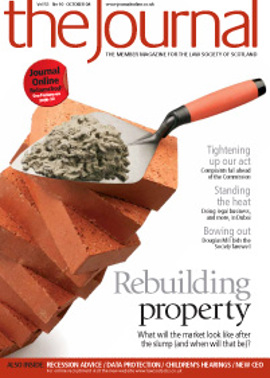CML Handbook: why the fuss?

On 26 August the Law Society of Scotland issued an e-bulletin to the profession indicating that the revised instructions in the CML Lenders’ Handbook, in respect of new-build properties which were introduced from 1 September 2008, were not appropriate to the Scottish market. Their advice is published in last month’s issue (Journal, September, 66). We do not accept this to be the case, and the attitude of the Society to this matter is in marked contrast to that of the professional bodies in other jurisdictions who have broadly welcomed the change.
The change is not simply, as the Society suggests, about discouraging fraud, although we fully accept that fraud has been a bigger issue in the new-build sector than any other area of the housing market, but is more about transparency of new-build prices and valuation. The real problem in the new-build sector has been the lack of transparency on the detail of all incentives offered by developers to purchasers, which has made it extremely difficult for both valuers and lenders to ascertain the actual price and value of the property.
This has resulted in loan-to-value ratios being skewed to a level higher than anticipated by the lender, thereby effectively increasing their exposure to risk without their knowledge. As a result, many lenders have tightened their lending criteria for the new-build sector when compared with other areas of the housing market. It is in light of this background that CML is making these changes to the handbook and introducing the disclosure of incentives form which will be completed by the developer of the property.
The changes which are being made are not only about the Lenders’ Handbook. We have been in discussions with both the Home Builders Federation and Homes for Scotland, who have both amended their codes of conduct to require greater transparency of price on behalf of their members. We have also seen a number of major builders take steps to address this issue within their organisations.
We have also been working with the Royal Institution of Chartered Surveyors, and changes will be made to their Red Book which will require the surveyor, when carrying out a valuation for mortgage purposes, to confirm whether or not they have seen the disclosure of incentives form. Most lenders have indicated to us that they are now unlikely to accept a valuation where the surveyor has not seen the form. Questions 5, 6 and 7, which contain some of the information which the Society seems to object to, are primarily for the benefit of the surveyor.
The form is a simple way of drawing together the information that a solicitor is already required to collect on behalf of the lender, as well as some additional information that is required for the surveyor. The intention behind the form is not to increase solicitors’ workload or increase their liability, but we would hope that it would make the existing duty to report incentives in terms of the handbook easier by having all the information in one place. This is how it is being viewed in other jurisdictions. We are not, as the Society suggests, asking the solicitor acting for the purchaser to verify the information contained in the form, but the solicitor should simply confirm with the purchaser that the information provided on the form regarding the agreed sale price and incentives offered is in line with the purchaser’s understanding.
Solicitors should thereafter report the incentives, as they are currently required to do, to the lender, following each lender’s instructions in part 2 of the Lenders’ Handbook, and contrary to Law Society of Scotland guidance should only forward the form to the lender if the lender requests this.
We do not understand the Society’s argument that the introduction of the form should result in significant delays in the conclusion of new-build missives, as solicitors are already required to report incentives to lenders in accordance with their part 2 instructions.
In summary, solicitors are simply being asked to confirm that prior to submitting their report on title, they have received the form and that they have reported to the lender on the incentives available, in terms of the lender’s instructions contained in part 2 of the Lenders’ Handbook.
In this issue
- IHT: spouses and the nil rate band
- Taking up the message
- SGM: support for review process
- Rebuilding to order?
- Nipped in the bud?
- Hearing better
- Dubai: an ever-expanding market
- When is a discharge not a discharge?
- Out of the hot seat
- Site to behold
- Now for the real thing
- Navigating the perfect storm
- Data, personal data and statistics
- Caring about sharing
- Rainmaker - or cloud on the horizon?
- The limits of belief
- Process queries
- Scottish Solicitors' Discipline Tribunal (1)
- Scottish Solicitors' Discipline Tribunal (2)
- From agreement to obligation
- Ganging up on exploitation
- Scottish Solicitors' Discipline Tribunal
- Website review
- Book reviews
- Up for the big event
- Old lessons hold good
- The revolution starts here?
- CML Handbook: why the fuss?






